Innovation capabilities in services: a multi-cases approach
Abstract
Through many years, services was perceived as non
-
innovative and complementary activities,
oriented mai
nly to produce goods. However,
the association between technological advances,
the rise of consumer participation
in service operations and the emergency
of
information and
communi
cation technology systems (ICT)
have allowed a proliferation of intermediate
activities in the productive s
ector alo
ng
a change in the economic perspective about services.
In addition, it is perceived the increased importance of innovation as a source of
competitiveness and a way to firms survive through time, which makes the comprehension of
the innovation pro
cess crucial in order to explain the service economy dynamics. Despite this,
innovation in services
–
including the analysis
of firm
capabilities
–
still is a poorly explored
subject. Considering the importance of services and innovation for the modern eco
nomy and
the peculiarities that differentiates services from tangible goods, the present
study
aims to better
understand how innovation takes place on services based on the capabilities approach. This w
as
done based on the related literature, identifying g
aps in the capabilities model and seeking new
conceptual insights in the field.
Results show that the
traditional capabilities framework is
limited to explain service’s innovation, as there is many levels of intangibility and non
-
linearity
in services’ off
erings. An altered model is suggested based on field’s discoveries, and a set of
propositions is made for future research.


